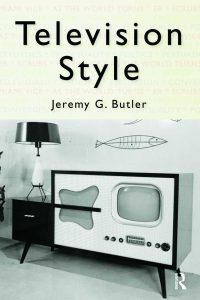“Television Style cuts through the cultural and academic haze that still clouds television, providing scholars and students with an incisive, comprehensive, and much-needed study detailing the intricacies and nuances of television as an artform.”
–John T. Caldwell, Professor of Cinema and Media Studies, UCLA, author of Production Culture: Industrial Reflexivity and Critical Practice in Film and Television and Televisuality: Style, Crisis, and Authority in American Television.
“Once upon a time in Hollywood, creative people treated TV like the annoying little brother who always wanted to play with the big kids. If you were a TV director, good luck making the leap into the more respectable medium. And, if you were a film director, why on earth would you deign to work for that tiny screen? Well, things have changed, to say the least. The old biases no longer apply, particularly when it comes to style, and Jeremy Butler has provided an account of a medium that has never been as dynamic as it is today. In the past decade, television style has evolved at a dizzying rate, and Butler charts the changes with a clear-eyed energy appropriate for a medium that, many agree, has left its elder sibling in the dust.”
–Ken Kwapis, film and television director, The Office, The Larry Sanders Show, and He’s Just Not That Into You.
“Television has grown more stylish in the last decade, and Butler’s book explain how and why this has happened. This book places film theory and criticism in dialogue with masterful research on television production to illuminate these important changes. The rise of single-camera television and the role of the TV director are finally given the credit they are due for making TV today as exciting as cinema ever was.”
–Ellen Seiter, Stephen K. Nenno Endowed Chair in Television Studies, USC, author of The Internet Playground: Childen’s Access, Entertainment and Mis-education and Sold Separately: Children and Parents in Consumer Culture.
“Jeremy Butler’s new book Television Style offers the best case I know for the claim that there is a distinct, and valuable, aesthetic of television.
Following his own study Television: Critical Methods and Applications and paying homage to John Caldwell’s pioneering Televisuality, Butler gets down to the details of how various TV genres use sound and image. Butler’s conception of genres is admirably broad, considering dramas, sitcoms, soap operas, and commercials, each with its own range of audiovisual conventions and production practices. His discussion of types of television lighting complements Keating’s analysis [Patrick Keating, Hollywood Lighting: From the Silent Era to Film Noir; put these together and you have some real advances in our understanding of key differences and overlaps between film and video.”
–David Bordwell, “Propinquities,” Observations on Film Art; Jacques Ledoux Professor of film studies, University of Wisconsin; co-author of Film Art and many other books.
